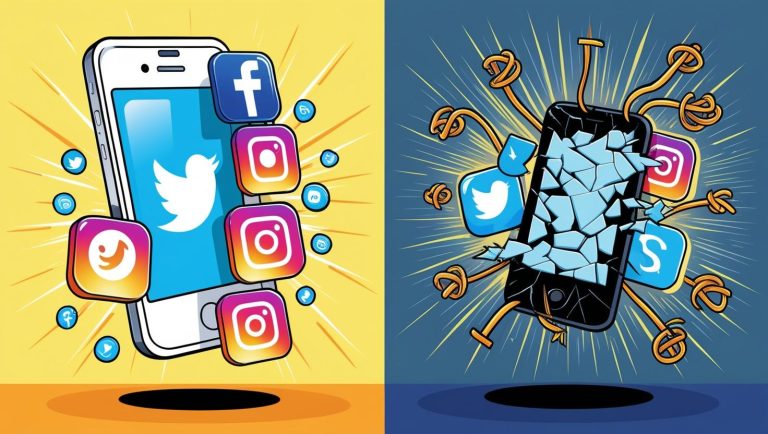The Double-Edged Sword: Social Media’s Impact on Mental Health
Social media has become an undeniable force in the 21st century, weaving its way into the fabric of our daily lives. From remote villages to bustling metropolises, billions of people connect, communicate, and consume information through platforms like Facebook, Instagram, X (formerly Twitter), TikTok, and countless others. For many, it’s become as essential as electricity or running water, a fundamental part of how we interact with the world. This interconnectedness offers unprecedented opportunities for communication, information sharing, and community building, shrinking the world and connecting individuals across geographical boundaries. However, this digital revolution comes at a cost, and the impact of social media on mental well-being has become a growing concern.
The benefits of social media are readily apparent. It bridges geographical distances, allowing families and friends to stay connected in real-time. Grandparents can witness the milestones of their grandchildren through shared photos and videos, while friends scattered across continents can maintain relationships through instant messaging and video calls. Beyond personal connections, social media facilitates the formation of online communities centered around shared interests, hobbies, or causes. These digital spaces provide a sense of belonging and support, allowing individuals to connect with like-minded people they might never have encountered otherwise. Moreover, social media has democratized information access, making news, research, and diverse perspectives readily available at our fingertips.
Despite these advantages, the very nature of social media presents significant challenges to mental health. The curated nature of online profiles, where users often present idealized versions of themselves, can fuel a culture of comparison. The constant barrage of vacation photos, career achievements, and seemingly perfect lives can lead to feelings of inadequacy, envy, and a distorted perception of reality. This is particularly concerning for younger users, whose sense of self-worth is still developing and who may be more susceptible to the pressures of social validation through likes, comments, and follower counts. This constant striving for online approval can contribute to anxiety, depression, and a diminished sense of self-esteem.
The addictive design of social media platforms further exacerbates these issues. The endless scroll, push notifications, and dopamine-driven feedback loops are engineered to maximize user engagement, often at the expense of real-world interactions, sleep, and other essential activities. This can lead to excessive screen time, contributing to a range of problems, from sleep disturbances and decreased productivity to increased stress and even burnout. The constant connectivity can also blur the lines between work and personal life, making it difficult to disconnect and recharge, further impacting mental well-being.
Cyberbullying, another dark side of the digital age, thrives in the often anonymous environment of social media. The lack of face-to-face interaction can embolden individuals to engage in hurtful behavior they might never exhibit in person. The consequences for victims can be devastating, leading to increased anxiety, depression, and even suicidal thoughts. The pervasive nature of online harassment, where hurtful comments and images can be shared widely and indefinitely, makes it particularly damaging. The feeling of being constantly under attack can be overwhelming and have long-lasting psychological effects.
Conversely, social media can also be a powerful tool for promoting mental health awareness and support. Mental health organizations, professionals, and individuals use these platforms to share valuable information, resources, and personal stories of recovery. Online support groups and communities offer safe spaces for individuals to connect with others facing similar challenges, reducing feelings of isolation and providing a sense of belonging. These digital platforms can be particularly helpful for those who lack access to traditional therapy or support networks, offering a crucial lifeline in times of need.
The key to navigating the complex relationship between social media and mental health lies in mindful and responsible usage. Setting boundaries, such as limiting screen time and curating one’s feed to follow positive and uplifting accounts, can significantly reduce the negative impacts. Regular digital detoxes, where individuals disconnect from social media for a period of time, can also be beneficial in restoring balance and reducing stress. Cultivating digital literacy and critical thinking skills is essential for discerning credible information from misinformation and developing a healthy skepticism towards the often-idealized portrayals of life online.
Parents and educators play a vital role in guiding young people towards a healthy relationship with social media. Open communication about online experiences, promoting self-awareness, and teaching digital literacy skills can empower young users to make informed choices and navigate the digital landscape safely. Tech companies also have a responsibility to prioritize user well-being by implementing features like screen time tracking, content moderation, and readily accessible mental health resources within their platforms. By working together, we can foster a digital environment that promotes mental well-being rather than exacerbating existing vulnerabilities. Ultimately, the impact of social media on mental health is not inherently positive or negative; it depends largely on how we choose to engage with it. By promoting mindful usage, fostering responsible online behavior, and prioritizing mental well-being, we can harness the power of social media for good while mitigating its potential harms.


